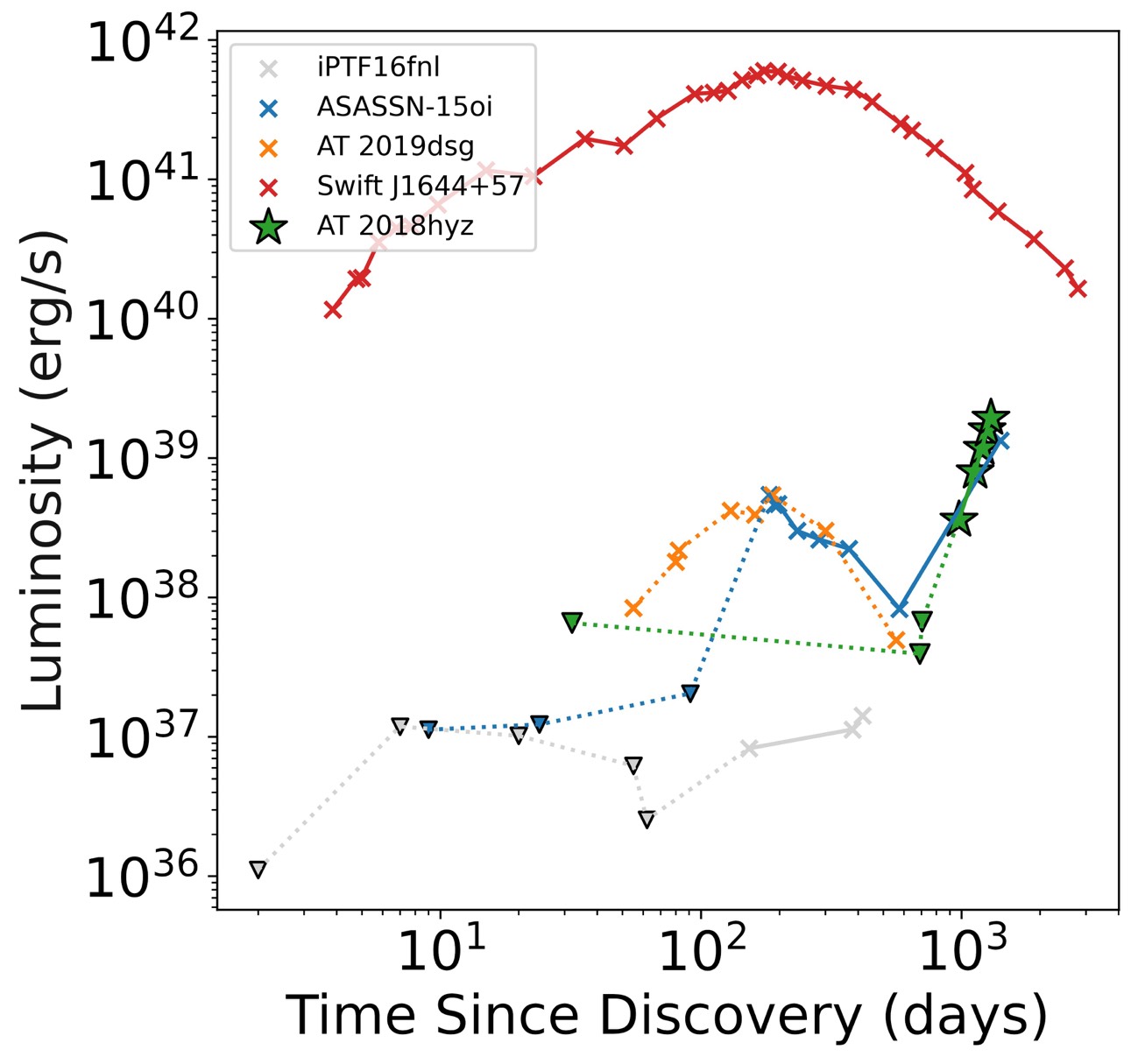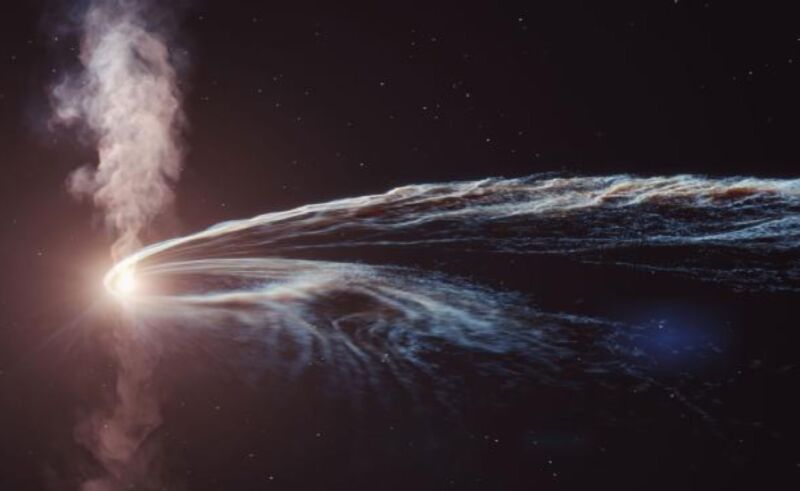Back in October 2018, astronomers spotted the bright flare of a star being shredded by a black hole 20 million times more massive than our Sun 665 million light years away—a so-called "tidal disruption event" (TDE) dubbed AT2018hyz. But otherwise the event seemed unremarkable, and after a few months of monitoring the black hole in visible light, the TDE faded, and astronomers moved on. But AT2018hyz had a surprise in store. Nearly three years later, the black hole suddenly reanimated, baffling astronomers, according to a new paper published in The Astrophysical Journal.
“This caught us completely by surprise—no one has ever seen anything like this before,” said co-author Yvette Cendes of the Harvard-Smithsonian Center for Astrophysics. She likened the unusual black hole-feeding behavior to “burping” after a heavy meal. "It's as if this black hole has started abruptly burping out a bunch of material from the star it ate years ago." This suggests that delayed outflow is more common than astronomers previously expected. The group will continue to monitor this TDE as it evolves, and a systematic study of a much larger sample of TDEs is underway.
As we've reported previously, it's a popular misconception that black holes behave like cosmic vacuum cleaners, ravenously sucking up any matter in their surroundings. In reality, only stuff that passes beyond the event horizon—including light—is swallowed up and can't escape, although black holes are also messy eaters. That means that part of an object's matter is actually ejected out in a powerful jet.
In a TDE, a star is shredded (or "spaghettified") by the powerful gravitational forces of a black hole outside the event horizon, and part of the star's original mass is ejected violently outward. This, in turn, can form a rotating ring of matter (aka an accretion disk) around the black hole that emits powerful X-rays and visible light. The jets are one way astronomers can indirectly infer the presence of a black hole. Those outflow emissions typically occur soon after the TDE.
When AT2018hyz was first discovered, radio telescopes didn't pick up any signatures of an outflow emission of material within the first few months. According to Cendes, that's true of some 80 percent of TDEs, so astronomers moved on, preferring to use precious telescope time for more potentially interesting objects. But last June, Cendes and her group decided to check back in on several TDEs over the last few years that hadn't shown any emission previously, using radio data from the Very Large Array (VLA). And lo and behold, AT2018hyz was lighting up the skies again.

“We have been studying TDEs with radio telescopes for more than a decade, and we sometimes find they shine in radio waves as they spew out material while the star is first being consumed by the black hole,” said co-author Edo Berger, an astronomer at Harvard University and the Center for Astrophysics. “But in AT2018hyz there was radio silence for the first three years, and now it’s dramatically lit up to become one of the most radio luminous TDEs ever observed.”
The next step was to apply for what's known as "Director's Discretionary Time" on several different telescopes across a broad spectrum of wavelengths. "When you find something so unexpected, you can't wait for the normal cycle of telescope proposals to observe it," said Cendes. Those applications were promptly accepted, giving the team data from the VLA, the ALMA Observatory in Chile, MeerKAT in South Africa, and the Australian Telescope Compact Array (ATCA) in Australia, as well as the space-based Chandra X-Ray Observatory and the Neil Gehrels Swift Observatory.
The analysis of all that data revealed that AT2018hyz was spewing out material at a whopping 1.4 millijansky at 5 GHz. "For those who don't speak radio, that's hella bright!" Cendes tweeted in an explanatory thread this past June when the preprint appeared, calling it "the greatest discovery of my life. This has never been seen before from a TDE, definitely never delayed a few years." (Fun fact: Cendes and her husband nicknamed AT2018hyz Jetty—short for "Jetty McJetFace.")
The TDE was an ongoing event as recently as this past April. "We think this is stellar material that was in an accretion disc after it got shredded," Cendes tweeted yesterday. "But why it took two years for this crazy outflow to happen is a mystery."
One possibility, per Cendes, is that the outflow density abruptly shifted, but the data doesn't support that. Nor does it support the possibility that there was a jet soon after the TDE, but astronomers didn't detect it right away because it wasn't pointed at Earth. The light increased much too quickly. Cendes also considered the possibility that there were two separate outflows interacting in an unusual manner but concluded it wasn't a likely scenario either.
"The most likely scenario is something called a 'state change,' where the accretion disc around the black hole transitioned to another kind of outflow," Cendes tweeted. "We see these around smaller black holes in our galaxy with donor stars giving them material, called X-ray binaries. So, if these state changes can happen in stellar-sized black holes in our galaxies, why wouldn't they around supermassive black holes that got an injection of material from a star?"
But if that's the case, there should be a significant excess of X-rays—and the data doesn't show that either. "Where does that leave us? We don't know!" Cendes concluded. "What we do know is AT2018hyz is doing something unpredicted and never seen before in a black hole, and we are going to keep monitoring it with all we've got. Hopefully additional observations will help us unravel the mysteries."
DOI: The Astrophysical Journal, 2022. 10.3847/1538-4357/ac88d0 (About DOIs).



3175x175(CURRENT).thumb.jpg.b05acc060982b36f5891ba728e6d953c.jpg)

Recommended Comments
There are no comments to display.
Join the conversation
You can post now and register later. If you have an account, sign in now to post with your account.
Note: Your post will require moderator approval before it will be visible.